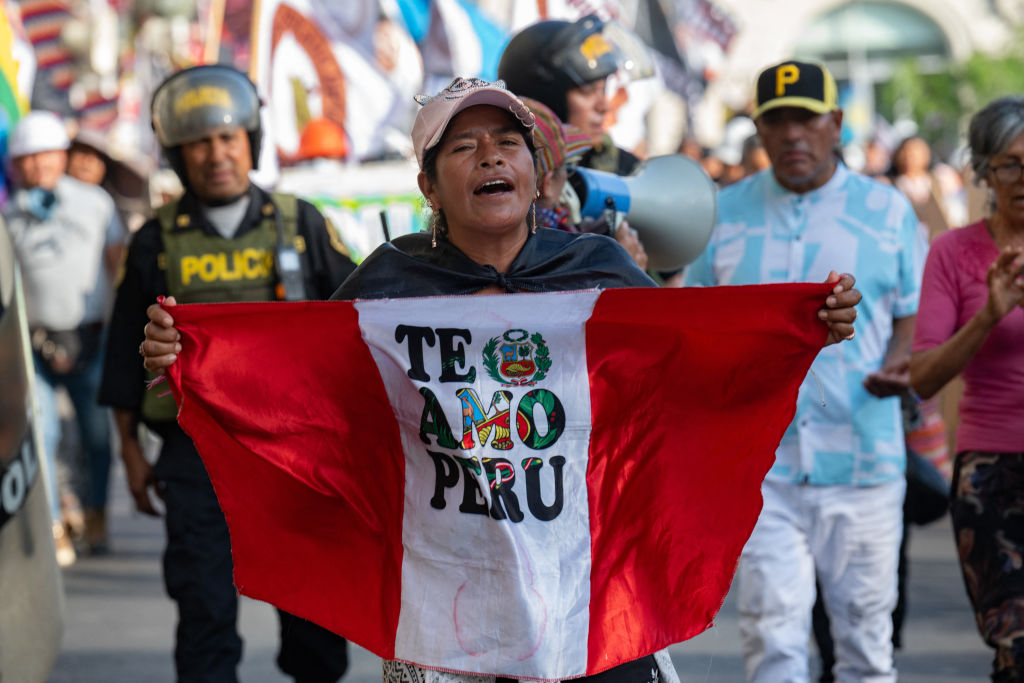Last year, hundreds of thousands of Mexicans, Venezuelans, Cubans, Colombians, and Ecuadorians reached the U.S.-Mexico border, pushed from their homes by a similar mix of factors: gang-led extortion and violence, stagnating economies, and governments too undemocratic or too corrupt to deliver solutions. Policymakers in Washington and the media took note.
Still, one country experiencing skyrocketing outmigration rarely makes the headlines: Peru. In 2022, over 400,000 Peruvians left the country without returning, more than in any year since 1990. In just the first half of 2023, another 400,000 left. While some have flown to Spain, a growing number of Peruvians are heading to the United States’ southern border, often after first traveling by air or by foot to Mexico. In early March, Mexico’s government announced plans to require visas from Peruvians for the first time since 2012, citing the fact that Mexican authorities had expelled Peruvians trying to enter the country over 35,000 times between 2021 and 2023, and had detained nearly 144,000 people coming from Peru trying to cross Mexico’s borders irregularly during the same years. Mexico’s government has yet to impose the new visa policy. Meanwhile, the U.S. Customs and Border Protection, or CBP, made 75,000 encounters with Peruvians at the U.S.-Mexico border in fiscal year 2023, slightly behind the same figure for Haitians.
The number of Peruvians arriving could soon grow even more significant. Over the past year, Peru has begun to slide down a dangerous path—call it the “outmigration trap”—that Haiti, Venezuela, and Central America’s northern triangle countries have taken before. The factors driving migration from each country are, of course, distinct. But there are similarities. In each case, unscrupulous politicians entrenched themselves in office and eroded the rule of law and democracy. Organized crime expanded while the formal economy suffered. And finally, once the future looked bleak enough, a steady stream of outmigration became a flood.
Too often, Washington begins paying attention only once countries reach that last step. But in Peru, there is an opportunity to do things differently. Over the past year, an alliance of lawmakers that dominates Peru’s Congress has pushed the country further toward the outmigration trap. Its leaders include self-described Marxist-Leninist Waldemar Cerrón (de facto leader of ex-President Castillo’s party), conservatives Keiko Fujimori and Rafael López Aliaga, and business moguls César Acuña and José Luna Gálvez. They share little more than their unpopularity—90% of Peruvians now disapprove of the performance of the nation’s Congress—and a litany of corruption investigations.
But over the past year, these leaders have often joined forces to tie the hands of prosecutors investigating crime and corruption, to purge and pack judicial bodies, and most recently, in March, to rewrite a third of the constitution. The last step barely made the news abroad, but it is the most dangerous. Lawmakers created a new upper chamber with no term limits to sidestep a ban on congressional re-election. The “Super-Senate,” as it has been called, will have sweeping power over the lower house, judiciary, and presidency. It’s the perfect tool to extend the pact’s hold on power past 2026.
That might sound highly unlikely, given the unpopularity of figures like Cerrón, Fujimori, and Luna Gálvez. However, the leaders of this pact are savvily preparing in advance; they partially or fully control the bodies that will choose new electoral authorities before 2026. There is now a risk that the 2026 elections will not occur on a level playing field but rather on terms that favor the parties and political operators currently in power. Alternatively, an autocrat-in-waiting could capitalize on Peruvians’ disgust with Congress and win the presidency.
A particular pact
This might sound more than a few steps removed from migration, like another chapter in Peru’s notoriously messy politics. But here’s the connection. The parties that make up the pact are implementing policies that exacerbate push factors for migration, like economic stagnation and organized crime, in service of their narrow benefit.
Congress has passed legislation making it harder for the state to police illegal logging and illegal mining—two booming industries that sow environmental destruction and enrich Peru’s criminal groups. Lawmakers have issued carve-outs allowing companies to avoid paying back taxes, even though Peru already collects close to the region’s lowest tax revenue as a share of GDP. And they have made it harder for prosecutors to strike plea deals, the key tool for investigating organized crime, even as Venezuela’s bloody Tren de Aragua gang has gained a foothold in Lima and Peru’s ports beckon to enterprising narco-traffickers.
Even more significant is what the pact hasn’t done: taken measures to head off economic stagnation. The days when Peru was reliably Latin America’s star economic performer are gone. The potential growth rate has sunk to half of what it was a decade ago, informality has increased, and investment in mining—the country’s biggest export sector—is only starting to rebound after a few rough years.
To take the right course, Peru needs to boost the quality of higher education to raise productivity, increase the share of formal sector jobs, and keep economic policymaking insulated from politics. But the pact has done the opposite, maneuvering to roll back quality controls on private universities (widely believed to finance congressional campaigns), catering to the robust informal sector, and giving the newly created Senate unilateral power to replace the central bank’s board of directors.
Although Peruvian society is almost unanimously opposed to the direction Congress is taking the country, political opposition is fragmented, disorganized, and, for now, leaderless. More than anything, after the mass unrest of late 2022-early 2023, policymakers in Washington seem wary of rocking the boat, quick to conclude that any effort on Peru will alienate a country considered a U.S. partner or fail to sway Peru’s Congress.
As Peru chooses new electoral authorities this year and next, even modest international attention on that process could go a long way toward ensuring free and fair elections. In early March, Senators Tim Kaine and Ben Cardin expressed concern about the legislature’s moves against Peru’s judiciary, and the U.S. Embassy in Lima got involved. U.S. pressure contributed to splits within the pact, which ultimately mustered up only enough votes to purge two of seven top magistrates. A court order reinstated the magistrates earlier this week, but Congress is appealing the ruling.
More engagement from higher levels of the State Department and major U.S. political parties will be necessary. Policymakers are understandably wary of considering targeted sanctions. However, the prospect of a Peruvian “Engel list” might be one of the few tools to avert the worst-case scenario: an attempt to swing 2026 elections by installing electoral officials loyal to the pact this year and next. Now is the time to act—before Peru becomes Latin America’s next migration crisis, not after.
—
This article was updated on April 1 to add in the second paragraph Mexico’s government plans to require visas from Peruvians for the first time since 2012.








